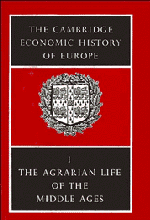Book contents
- Frontmatter
- Chapter I The Settlement and Colonization of Europe
- Chapter II Agriculture and Rural Life in the Later Roman Empire
- Chapter III The Evolution of Agricultural Technique
- Chapter IV Agrarian Institutions of the Germanic Kingdoms from the fifth to the ninth century
- Chapter V Agrarian conditions in the Byzantine Empire in the Middle Ages
- Chapter VI The Rise of Dependent Cultivation and Seignorial Institutions
- Chapter VII Medieval Agrarian Society in its Prime
- Chapter VIII Crisis: From the Middle Ages to Modern Times
- BIBLIOGRAPHIES
- Plate Section
- The Roman frontier and the Teutonic Tribes in the first and fourth centuries A.D.
- The Empire of Charles the Great
- Germany in the thirteenth century
- References
Chapter V - Agrarian conditions in the Byzantine Empire in the Middle Ages
Published online by Cambridge University Press: 28 March 2008
- Frontmatter
- Chapter I The Settlement and Colonization of Europe
- Chapter II Agriculture and Rural Life in the Later Roman Empire
- Chapter III The Evolution of Agricultural Technique
- Chapter IV Agrarian Institutions of the Germanic Kingdoms from the fifth to the ninth century
- Chapter V Agrarian conditions in the Byzantine Empire in the Middle Ages
- Chapter VI The Rise of Dependent Cultivation and Seignorial Institutions
- Chapter VII Medieval Agrarian Society in its Prime
- Chapter VIII Crisis: From the Middle Ages to Modern Times
- BIBLIOGRAPHIES
- Plate Section
- The Roman frontier and the Teutonic Tribes in the first and fourth centuries A.D.
- The Empire of Charles the Great
- Germany in the thirteenth century
- References
Summary
East and West in the Roman Empire
The eastern half of the Roman Empire was economically stronger and more thickly populated than the western half, and it survived the crisis in which the latter perished, though only after the most exhausting and difficult external and internal struggles. For even the sounder eastern half of the Roman polity had the same troubles as the western half, and in spite of all their differences the political, as well as the economic, and particularly the agrarian, conditions were in many ways similar. The decline in the population did not make itself felt so severely in the East as in the West, while in the former with its overabundance of cities the growth of latifundia was accomplished more slowly. But here, too, for centuries development was affected by the marked shortage of labour and by the increase in private estates. And here, also, there were the same results – the wide-spread absorption of the state lands and of the small landowner, and the binding of the peasant to the soil. This process was vigorously opposed by the more highly centralized government of the East, but such opposition was limited by the financial needs of the state; and to the very end it remained unsuccessful.
These financial needs of the state were at all times responsible for the moulding of agrarian conditions in Byzantium. The taxation of Diocletian had imposed the hereditary ground tax on the peasant, and the so-called capitatio-iugatio which he created continued throughout the early Byzantine period, linking together the head and ground taxes. Regarded from different points of view caput and iugum denote the same taxable value: the iugum is the piece of land that can feed a caput, and the caput stands for the human labour expended on a iugum. And so the capitatio, just like the iugatio, is related to the actual soil, and a caput cannot represent either townsfolk or the landless. In the same way, a iugum, in order to be taxable, must have its corresponding caput
Keywords
- Type
- Chapter
- Information
- Publisher: Cambridge University PressPrint publication year: 1966
References
- 11
- Cited by



